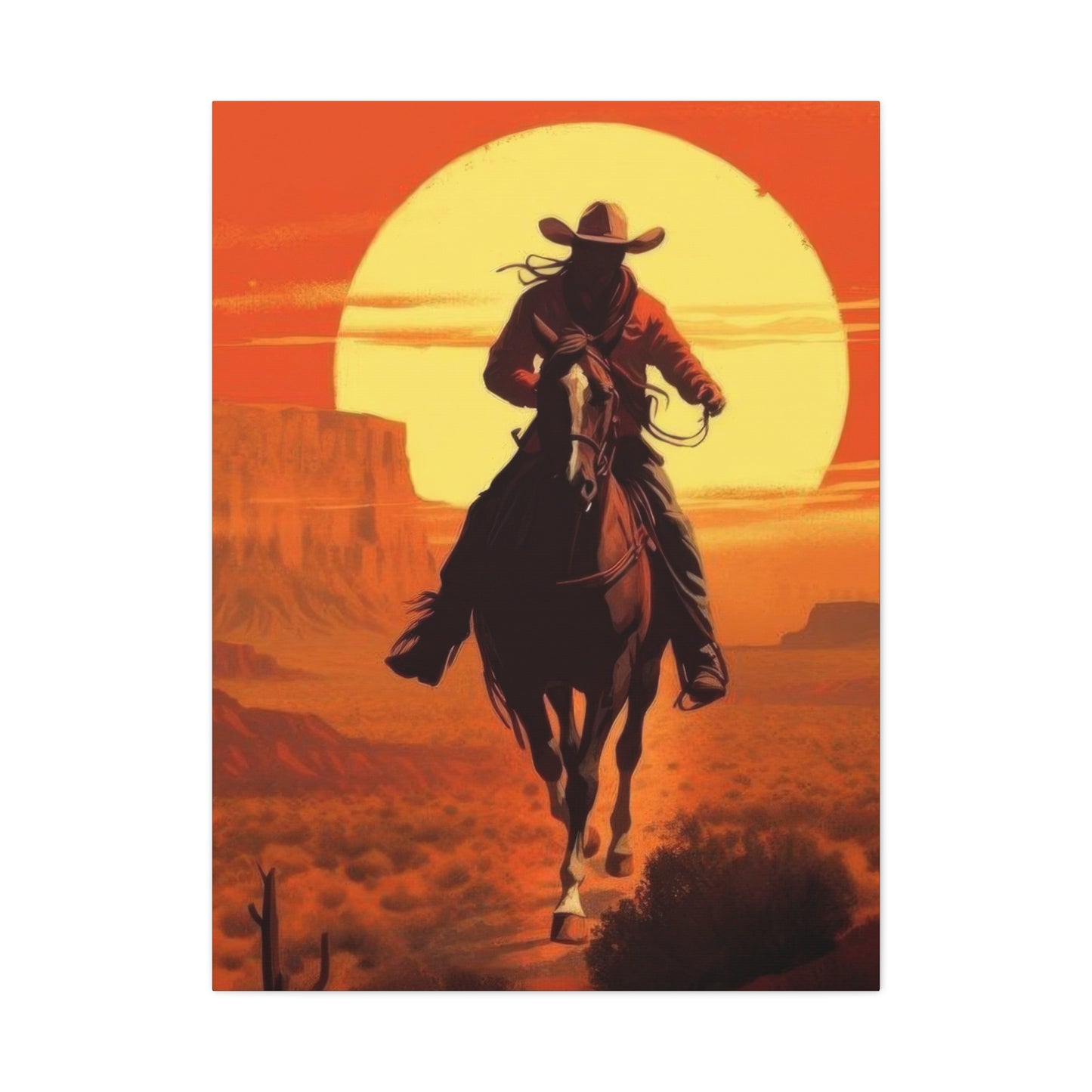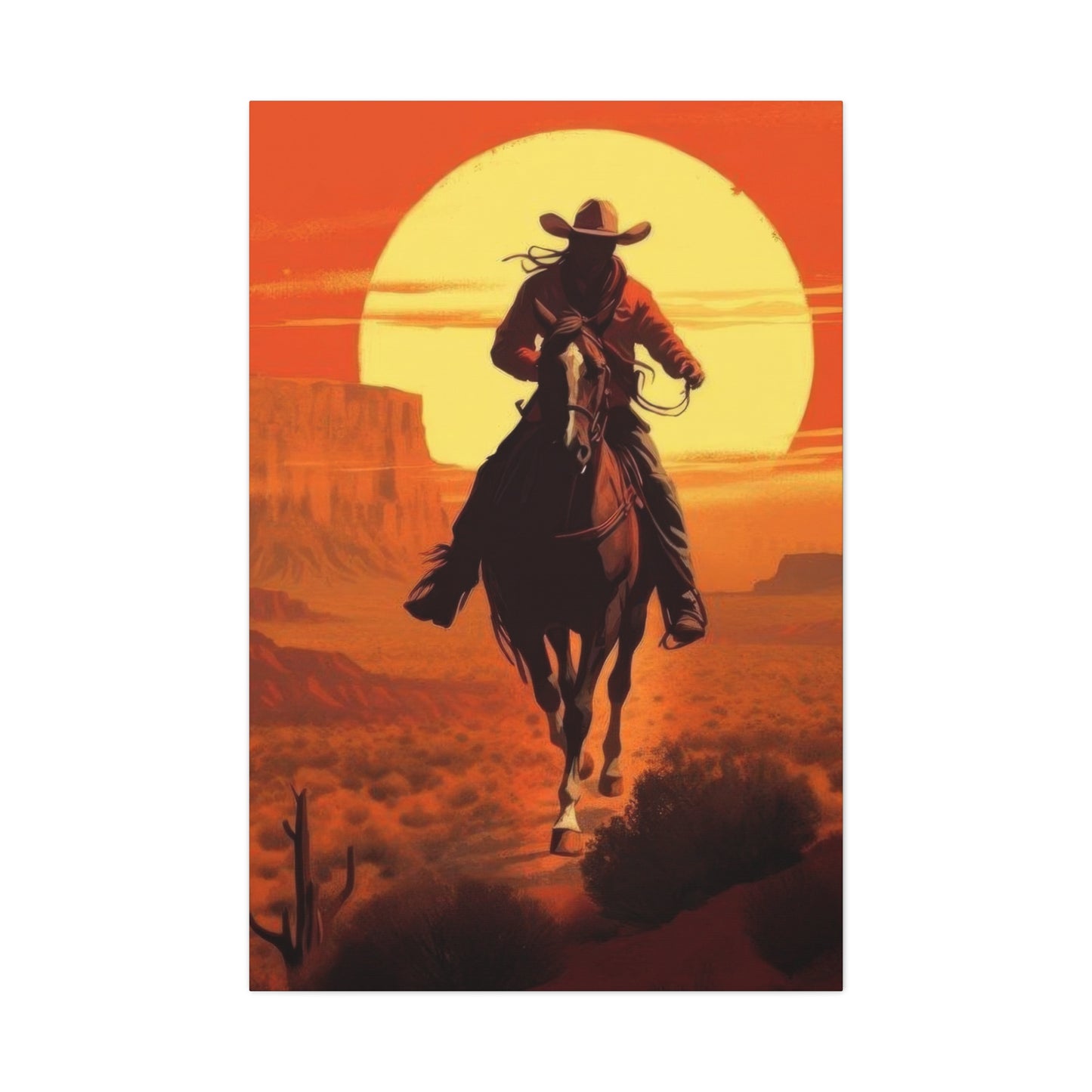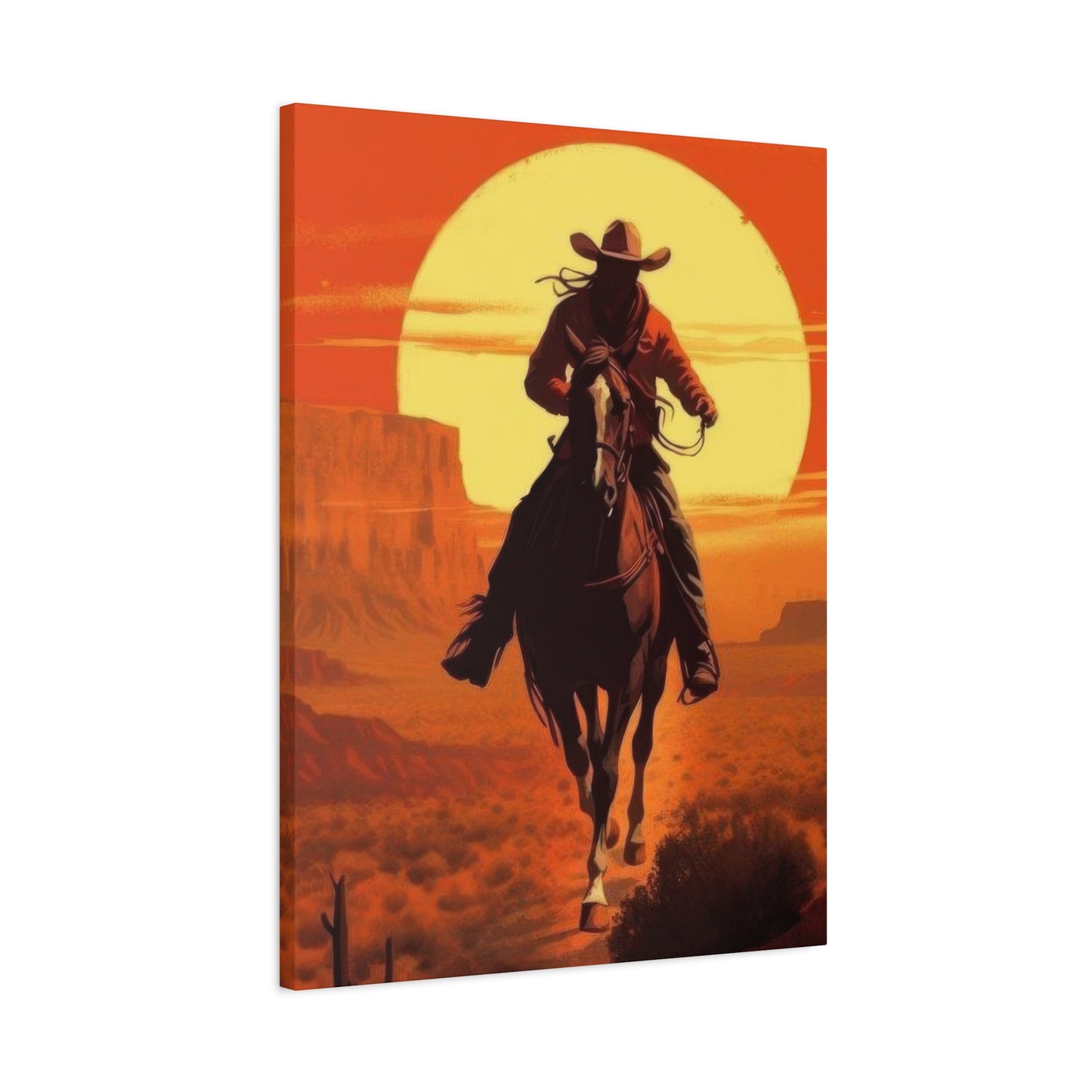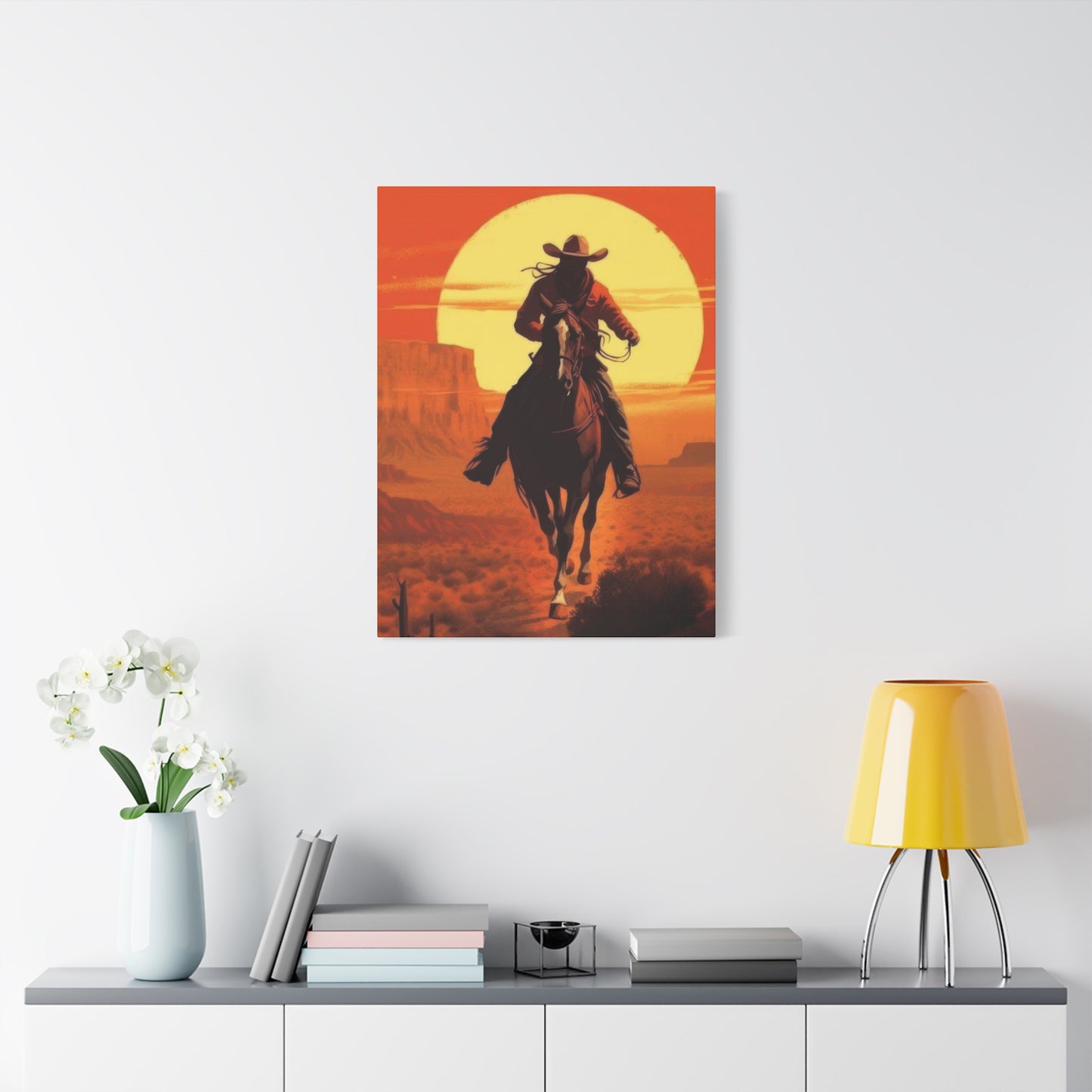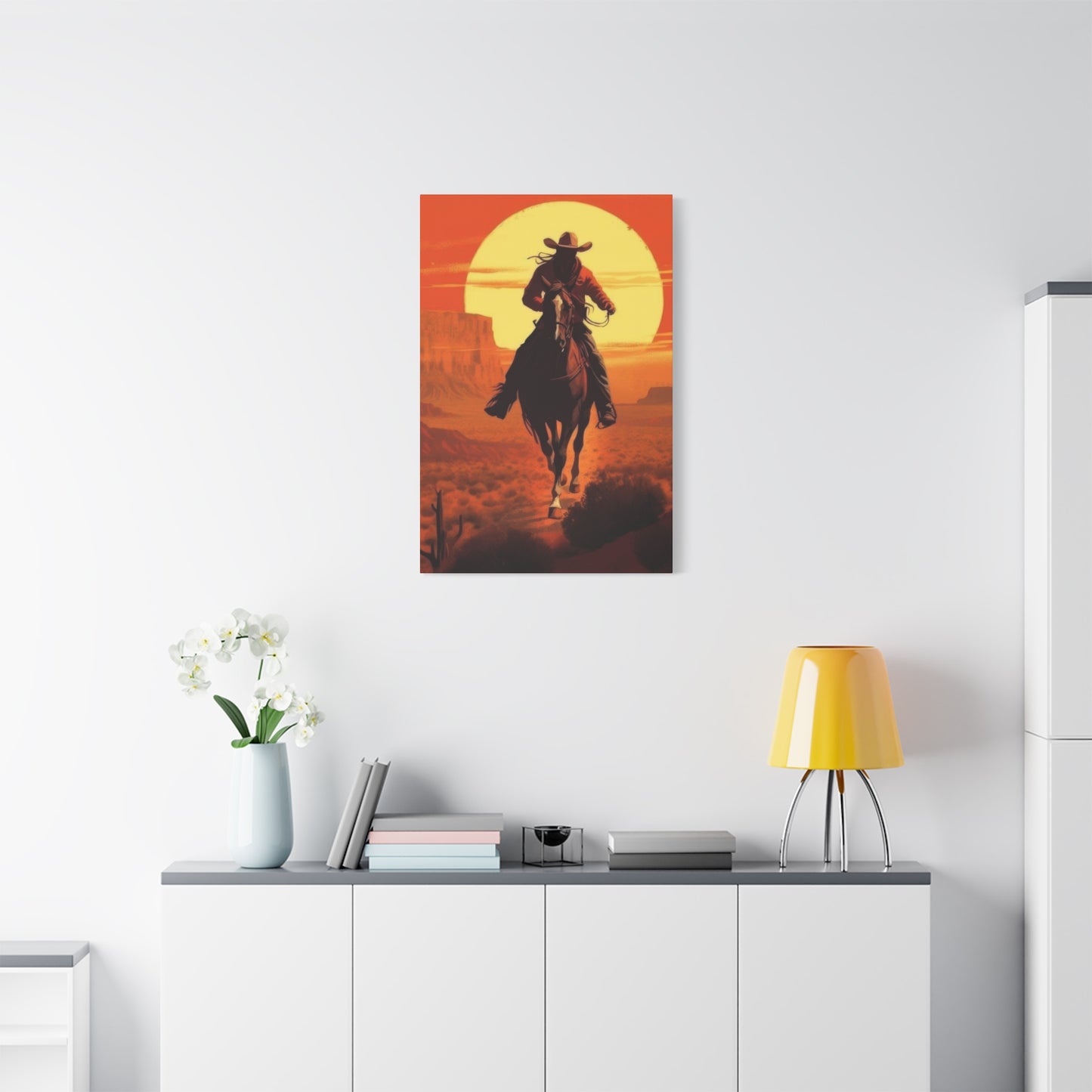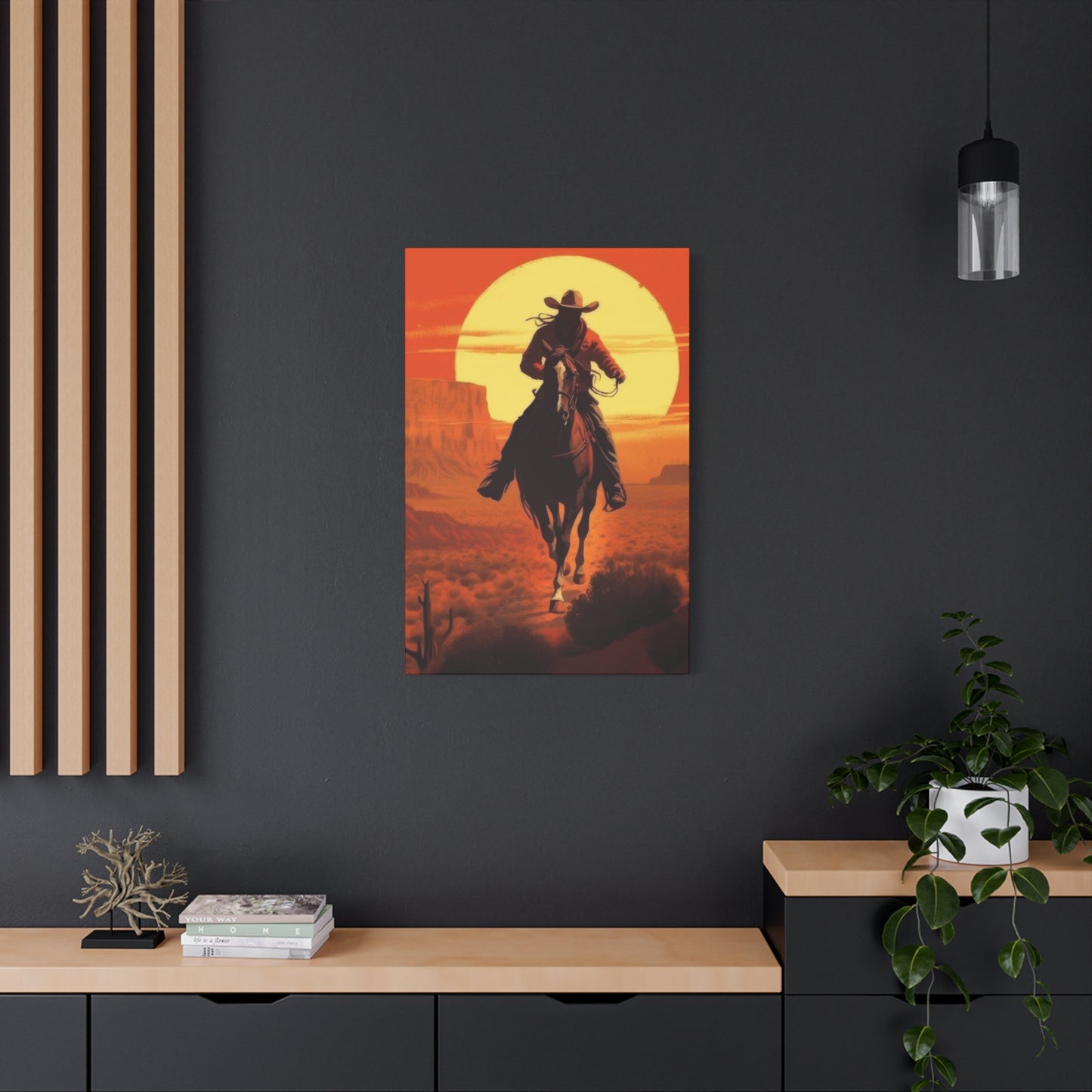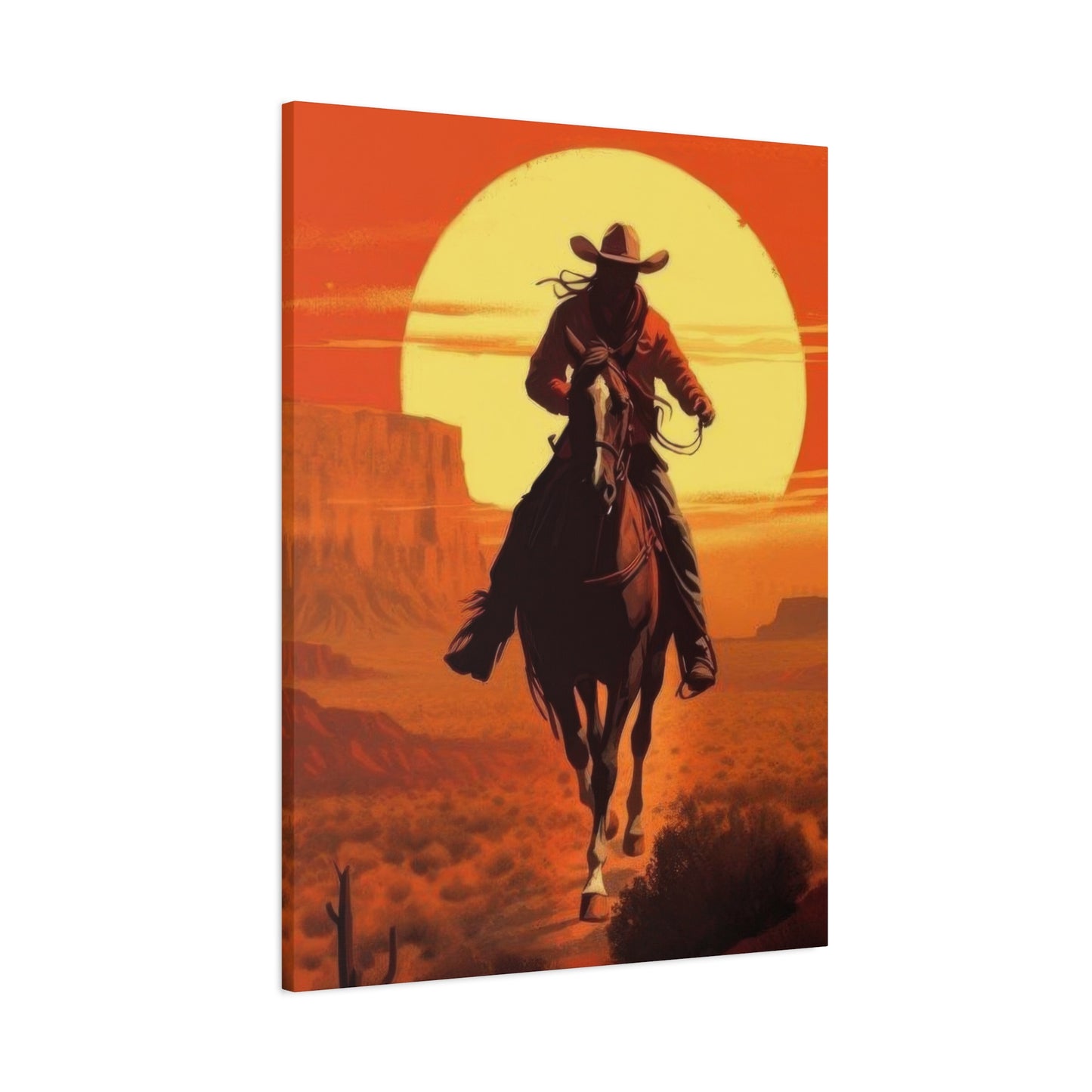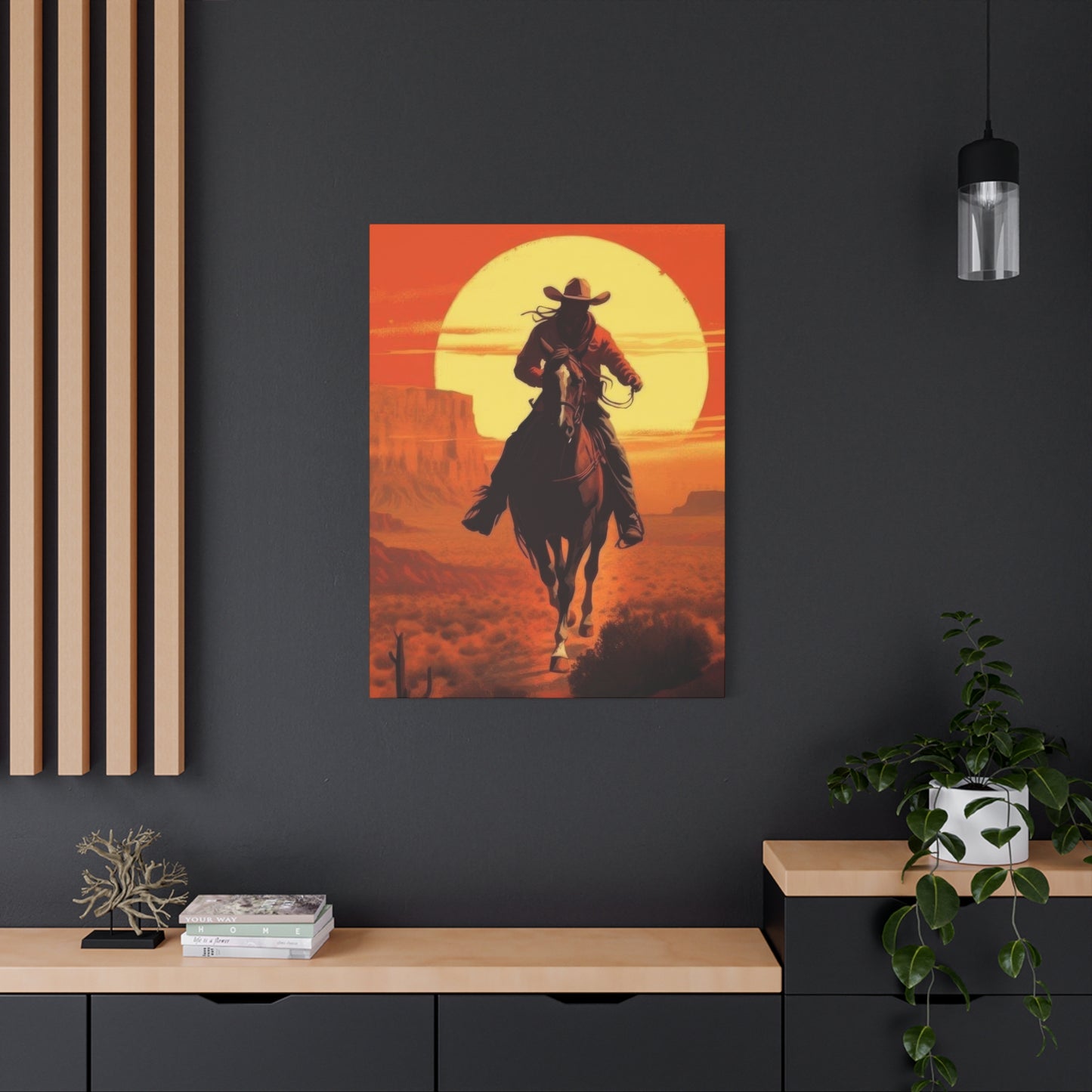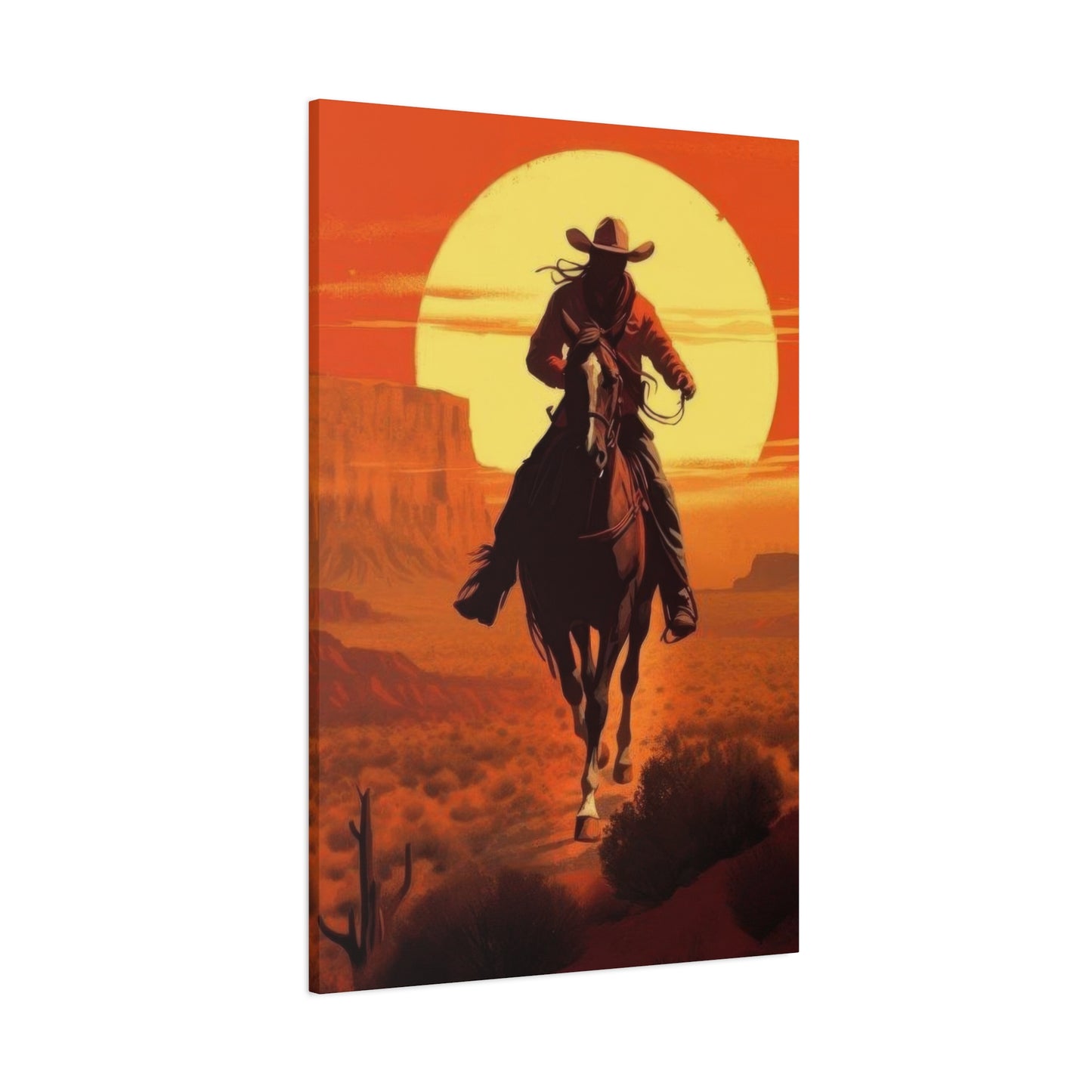Desert Dusk to Living Room Luxe: Decorating with Cowboy Sunset Wall Art
The allure of the American frontier continues to captivate hearts and minds across generations, and few artistic representations capture this spirit more powerfully than imagery depicting a solitary rider journeying through the fading daylight. The combination of rugged wilderness landscapes, equestrian figures, and the warm palette of dusk creates an emotional resonance that transforms ordinary living spaces into portals to another era. This comprehensive exploration delves into every aspect of decorating with western-themed canvas artwork, examining the cultural significance, artistic techniques, interior design applications, and the enduring appeal of these timeless pieces.
Cowboy Through Sunset Wall Art
The visual narrative of a horseman traversing landscapes bathed in the golden light of evening represents more than mere decoration. These artistic compositions embody fundamental human experiences including solitude, journey, determination, and the relationship between humanity and untamed nature. When displayed prominently in residential or commercial spaces, such artwork immediately establishes an atmosphere of contemplation and adventure.
The technical execution of these pieces typically involves careful attention to atmospheric perspective, where distant mountains fade into progressively lighter tones that mirror the gradual transition from earth to sky. The silhouetted figure of the rider often serves as the compositional anchor, creating a striking contrast against the luminous background. This deliberate use of backlighting emphasizes form over detail, allowing viewers to project their own narratives onto the anonymous figure.
Modern printing technologies have revolutionized accessibility to museum-quality reproductions, enabling enthusiasts to acquire stunning representations of western sunset scenes without the prohibitive costs associated with original paintings. High-resolution digital captures preserve every brushstroke and color nuance from source materials, while advanced canvas substrates provide authentic texture that closely resembles hand-painted works. The archival quality of contemporary inks ensures these pieces maintain their visual impact for decades when properly displayed away from direct sunlight and excessive humidity.
Interior designers frequently recommend these compositions for spaces requiring focal points that command attention without overwhelming surrounding elements. The horizontal orientation common to landscape formats naturally draws the eye across the composition, making them particularly effective above sofas, beds, or console tables. The warm color palette dominated by oranges, reds, and golden yellows creates inviting atmospheres that enhance comfort and relaxation in living areas, bedrooms, and hospitality environments.
Collectors appreciate the versatility inherent in western sunset imagery, as these pieces complement diverse decorating schemes ranging from rustic farmhouse aesthetics to contemporary minimalist interiors. The timeless subject matter transcends fleeting design trends, ensuring these investments remain relevant regardless of evolving style preferences. Whether presented as single statement pieces or incorporated into gallery wall arrangements, the imagery maintains its emotional impact and visual coherence.
The psychological effect of displaying such artwork extends beyond simple aesthetic pleasure. Research in environmental psychology suggests that landscape imagery, particularly scenes featuring natural elements and open spaces, can reduce stress and promote mental wellbeing. The addition of human or animal figures provides relational context that enhances engagement, encouraging viewers to imagine themselves within the depicted scenario. This participatory quality distinguishes narrative artwork from purely decorative elements.
Selecting appropriate sizing requires careful consideration of wall dimensions and viewing distances. Large-scale presentations measuring forty-eight inches or greater in width create dramatic impact suitable for expansive walls in great rooms or commercial lobbies. Medium-sized options between twenty-four and forty-eight inches work well in standard residential settings, while smaller dimensions serve effectively in offices, hallways, or as components within larger arrangements. Professional framers often recommend that artwork width should span approximately two-thirds to three-quarters of the furniture width beneath it to achieve balanced proportions.
Sunset Rider Canvas Prints
The specific category of equestrian figures captured during the transitional period between day and night offers particular artistic and emotional richness. These compositions leverage the dramatic lighting conditions present during the final hour before darkness to create images of extraordinary beauty and depth. The low angle of sunlight during this period produces elongated shadows, enhanced color saturation, and atmospheric effects impossible to replicate at other times.
Canvas as a substrate brings distinct advantages to photographic and painted reproductions of western scenes. The textured surface mimics traditional artistic mediums, providing dimensional quality that flat paper prints cannot achieve. When stretched over wooden frames and mounted with gallery-wrapped edges, these pieces require no additional framing, offering clean contemporary presentation that emphasizes the image itself rather than ornamental borders. The fabric construction also provides superior durability compared to paper alternatives, resisting tears and maintaining structural integrity even in high-traffic areas.
Artists working within this genre draw inspiration from historical precedents established by renowned western painters who documented frontier life during the nineteenth and early twentieth centuries. These masters understood the technical challenges of capturing moving subjects under rapidly changing light conditions, developing techniques for suggesting motion, atmosphere, and mood through economical brushwork and strategic color placement. Contemporary interpretations honor these traditions while incorporating modern sensibilities regarding composition and color theory.
The emotional narrative embedded within rider imagery speaks to universal themes of independence, exploration, and the human desire to test oneself against natural challenges. The solitary figure represents individualism and self-reliance, values deeply embedded in cultural mythology surrounding the American West. Viewers respond to these symbolic elements on conscious and subconscious levels, forming personal connections with artwork that reflects their own aspirations or memories.
From technical printing perspectives, reproducing sunset scenes presents specific challenges related to color accuracy and tonal gradation. The smooth transitions from deep oranges to pale yellows require sophisticated color management systems and high-quality printing equipment capable of producing subtle gradients without banding artifacts. Premium canvas prints utilize twelve-color printing processes rather than standard four-color methods, enabling reproduction of extended color gamuts that more faithfully represent original artwork.
Installation considerations for canvas prints differ somewhat from traditionally framed pieces. The wrapped edges allow flush mounting directly against walls without protruding frames, creating streamlined profiles appropriate for modern interiors. However, mounting hardware must adequately support the weight of stretched canvas and wooden stretcher bars, typically requiring wall anchors rated for loads exceeding the artwork weight by comfortable margins. Professional installation services ensure secure mounting while preventing damage to walls or artwork.
Maintenance requirements remain minimal for properly produced canvas prints. Regular dusting with soft microfiber cloths removes accumulated particles without abrading printed surfaces. Occasional inspection for loose stretcher bars allows tightening of any connections that may loosen over time due to environmental fluctuations. Avoiding placement near heat sources, air conditioning vents, or areas with high humidity exposure extends the longevity of both canvas substrate and printed imagery.
The investment value of quality canvas reproductions has increased as production standards have risen. While original paintings command premium prices reflecting artist skill and uniqueness, professionally produced canvas prints offer comparable visual impact at accessible price points. Limited edition numbered prints signed by artists or publishers carry enhanced collectibility, potentially appreciating as subsequent print runs sell out. Certificates of authenticity accompanying such editions provide documentation useful for insurance purposes and future resale scenarios.
Western Cowboy at Sunset Wall Décor
Decorative applications of frontier-themed artwork extend across residential, commercial, and hospitality environments, each context presenting unique opportunities for creative expression. Understanding how these pieces function within different settings enables informed selection that maximizes both aesthetic and functional objectives.
In residential contexts, living rooms and great rooms offer prime opportunities for showcasing large-scale western sunset compositions. These communal spaces benefit from artwork that facilitates conversation and creates memorable impressions for guests. Positioning significant pieces above fireplaces or primary seating arrangements establishes them as room focal points around which other design elements orbit. The warm tones characteristic of sunset imagery complement earthy color schemes incorporating browns, tans, and terracotta hues commonly featured in southwestern and rustic decorating styles.
Bedrooms represent another excellent venue for this imagery category, particularly in master suites where homeowners seek to create personal retreats reflecting individual interests and passions. The calming influence of landscape scenes promotes relaxation conducive to quality sleep, while the adventurous spirit embodied in horseback rider figures maintains elements of vitality and aspiration. Positioning artwork opposite the bed ensures it becomes the first visual element encountered upon waking, setting positive emotional tones for the day ahead.
Home offices and personal studies gain character and inspiration from western-themed décor that reinforces qualities of determination, independence, and perseverance. Professionals working from home environments frequently report that surrounding themselves with imagery reflecting their values and interests enhances motivation and productivity. The journey narrative inherent in sunset rider compositions metaphorically represents career progression and goal pursuit, providing subtle psychological reinforcement during challenging work periods.
Commercial applications range from restaurants and hospitality venues to corporate offices and retail environments. Western-themed restaurants, steakhouses, and breweries naturally gravitate toward authentic frontier imagery that reinforces brand identity and creates immersive dining experiences. Hotels in western regions utilize regional artwork to establish strong sense of place, helping guests feel connected to local culture and history. Corporate environments, particularly those in industries with western heritage such as ranching, agriculture, or outdoor recreation, employ this décor to communicate company values and regional pride.
Retail spaces including home furnishing stores, western wear boutiques, and galleries showcase these pieces both as merchandise and as environmental elements enhancing shopping atmospheres. Effective display techniques demonstrate how customers might incorporate similar pieces into their own spaces, simultaneously inspiring purchases and educating consumers about styling options. Thoughtful lighting design highlighting key artworks draws attention and creates dramatic effects that elevate perceived value.
The scale relationship between artwork and wall space critically impacts visual success. Undersized pieces disappear on expansive walls, failing to command adequate attention or establish proper compositional balance. Conversely, oversized artwork on small walls creates cramped, overwhelming impressions that diminish viewing pleasure. Design professionals employ mathematical ratios and visual measurement techniques to determine optimal sizing, generally recommending that artwork fills between fifty and seventy-five percent of available wall width above furniture pieces.
Grouping strategies offer alternatives to single large statements, particularly when working with collections or when budget constraints limit individual piece sizes. Symmetrical arrangements of two or three similarly sized panels create cohesive visual units that combine to achieve impact comparable to larger single pieces. Asymmetrical gallery wall compositions incorporating various sizes generate dynamic energy appropriate for casual spaces. Maintaining consistent framing styles and thematic coherence across grouped pieces prevents disjointed appearances.
Color coordination between artwork and surrounding décor elements reinforces design harmony without requiring exact matching. Pulling accent colors from the sunset palette into throw pillows, area rugs, or decorative accessories creates intentional connections that unify rooms. Conversely, selecting complementary colors from opposite positions on the color wheel generates vibrant contrast that energizes spaces. Neutral wall colors including warm whites, soft grays, and beige tones provide versatile backgrounds that allow artwork to dominate visually without competing with strong wall hues.
Lone Cowboy in the Setting Sun Art
The motif of a solitary figure silhouetted against the descending sun carries profound symbolic weight that transcends simple decorative appeal. This archetypal image taps into deep cultural narratives about individualism, self-discovery, and the relationship between humanity and vast natural forces. Understanding these symbolic dimensions enriches appreciation and enables more meaningful selection processes.
Isolation within the composition serves multiple functions simultaneously. Physically, it emphasizes the scale of surrounding landscapes, rendering human presence small within expansive environments. This proportion communicates humility before nature while simultaneously celebrating human courage in confronting overwhelming wilderness. The psychological dimension resonates with viewers who identify with feelings of independence or who seek reminders that solitary journeys sometimes yield profound rewards.
The directional movement typically depicted toward the light source rather than away from it imbues compositions with forward momentum and optimism. This compositional choice suggests purposeful travel toward goals rather than aimless wandering, aligning with aspirational narratives about pursuing dreams despite obstacles. The literal journey into the sunset carries metaphorical weight regarding life transitions, endings that enable new beginnings, and the courage required to venture into unknown territories.
Silhouetting techniques eliminate facial features and individual details, creating universal figures with whom diverse viewers can identify regardless of their backgrounds. This anonymity functions as an invitation for projective identification, enabling each observer to imaginatively inhabit the depicted role. The absence of specific identity markers paradoxically makes these images more personally meaningful to wider audiences than highly detailed portraits of particular individuals.
Color symbolism within sunset palettes contributes additional layers of meaning. Orange hues suggest warmth, energy, and enthusiasm. Red tones evoke passion, courage, and vitality. Golden yellows communicate optimism, enlightenment, and prosperity. Purple shadows appearing in deepening dusk add mystery and spirituality. Artists manipulate these color associations deliberately, adjusting palette balances to emphasize particular emotional qualities desired for specific compositions.
Historical connections to actual frontier experiences lend authenticity that distinguishes western imagery from purely fictional fantasy landscapes. The depicted scenarios reference real practices of horseback travel across vast distances, overnight camps beneath open skies, and the practical challenges of navigation without modern technology. This grounding in historical reality provides depth that purely imaginative subjects lack, creating bridges between contemporary viewers and ancestors who actually lived these experiences.
Contemporary relevance persists despite the historical setting through universal themes that transcend specific time periods. Modern viewers facing career uncertainties, relationship challenges, or personal growth endeavors find metaphorical resonance in imagery depicting individual journeys through uncertain terrain toward distant horizons. The western setting provides aesthetic framework for examining timeless questions about purpose, perseverance, and personal authenticity.
Technical execution distinguishes exceptional interpretations from mediocre attempts. Masterful handling of atmospheric perspective creates convincing spatial depth through progressive lightening and cooling of distant elements. Skilled rendering of dust, moisture, or heat distortions in the atmosphere adds environmental specificity that enhances realism. Subtle inclusion of foreground details such as desert vegetation or rock formations provides visual interest without distracting from primary subjects.
Emotional impact correlates strongly with compositional choices regarding figure placement, horizon line position, and negative space distribution. Centering figures creates stable, contemplative moods. Off-center positioning generates dynamic tension and implied narrative momentum. Low horizon lines emphasize sky drama and suggest vast distances ahead. High horizons focus attention on terrain features and immediate environments. Thoughtful manipulation of these variables enables artists to guide viewer emotional responses toward intended experiences.
Cowboy Silhouette Against Sunset Canvas
The artistic decision to render human and equine subjects primarily as dark shapes against illuminated backgrounds represents sophisticated understanding of visual perception and emotional impact. This approach sacrifices surface detail in favor of powerful form recognition and dramatic contrast ratios that command immediate attention.
Silhouette techniques trace back to ancient shadow art traditions but gained particular prominence in portraiture before photography became widespread. The term itself derives from French finance minister Étienne de Silhouette, whose profile portrait cut from black paper became associated with economical representation. Western artists adapted these techniques for landscape contexts, discovering that backlighting conditions naturally occurring during sunrise and sunset provided ideal circumstances for capturing compelling silhouetted forms.
The psychological impact of silhouetted imagery stems partly from the brain's remarkable facility for pattern recognition. Human visual systems identify familiar shapes even when reduced to simple outlines, filling in assumed details from memory and experience. This cognitive process actively engages viewers, making them participants in image completion rather than passive observers. The mental effort required creates stronger memory formation and emotional investment compared to fully detailed representations.
Compositional strength in silhouette work depends heavily on recognizable profile shapes and characteristic postures. Horseback riders present particularly effective subjects because the combined human-animal form creates distinctive outlines immediately identifiable even at small scales or quick glances. The elevated position of mounted figures naturally produces dynamic profiles that communicate motion and purpose. Varying leg positions, rein angles, and head tilts introduce subtle individuality while maintaining overall silhouette clarity.
Technical challenges in capturing or creating effective silhouettes involve precise exposure control. Photographers shooting into bright backgrounds must significantly underexpose foreground subjects to render them as pure blacks without preserving detail. This requires either manual exposure override or post-processing adjustments that deepen shadows to desired density levels. Painters working from imagination or reference materials must resist the temptation to add inappropriate highlights or details that would compromise silhouette integrity.
The contrast between darkened foreground elements and brilliant sunset skies creates maximum visual impact through juxtaposition of extreme tonal values. This dynamic range captures attention more effectively than images occupying middle tonal ranges exclusively. The stark division between light and dark areas also simplifies compositions, eliminating potentially distracting details and focusing viewer attention on essential forms and gestures.
Symbolic implications of darkness representing the figure while light dominates the background carry interpretive possibilities. Some viewers perceive this as the individual confronting or traveling toward enlightenment, wisdom, or spiritual truth. Others interpret the darkness as representing mystery, the unknown aspects of human character, or the shadow self in psychological terms. These multiple interpretive layers contribute to the enduring fascination with silhouetted imagery across cultures and time periods.
Canvas presentations of silhouetted compositions benefit particularly from gallery-wrap mounting techniques where the image continues around the edges of the stretched frame. This borderless presentation reinforces the dramatic simplicity of silhouette designs, avoiding ornamental frames that might detract from the austere power of the imagery. The continuous image surface creates immersive effects, suggesting that the depicted scene extends beyond visible borders into infinite space.
Lighting considerations for displayed silhouette artwork differ from requirements for detailed paintings. These high-contrast compositions tolerate and even benefit from dimmer ambient lighting that might obscure subtleties in more nuanced works. The strong tonal separation ensures visibility under varied conditions. Strategic accent lighting directed at an angle across the canvas surface can enhance texture perception without washing out the image through excessive brightness or reflection glare.
Color temperature of illumination sources affects the perceived warmth of sunset palettes. Warm white or soft white bulbs with color temperatures around three thousand Kelvin reinforce the golden, amber qualities inherent in sunset scenes. Cool white or daylight-balanced sources above four thousand Kelvin introduce blue casts that can appear sterile or diminish the intended warmth. LED strip lighting concealed behind canvas edges creates dramatic halo effects that extend the glow of depicted sunsets into physical space.
Western Sunset Canvas Wall Art
The broader category encompassing diverse approaches to capturing the unique beauty of western landscapes during the transitional hours of dusk offers extraordinary variety within recognizable parameters. This diversity enables collectors to find pieces precisely aligned with personal preferences regarding style, mood, color intensity, and level of detail.
Geographic specificity varies considerably across different works. Some artists favor generic western scenery emphasizing universal characteristics such as open skies, distant mountains, and sparse vegetation without identifying particular locations. Others meticulously recreate recognizable landmarks including distinctive rock formations, specific mountain ranges, or historically significant sites. Regional variations between Southwest desert environments, Great Plains grasslands, and Rocky Mountain elevations produce distinctly different aesthetic qualities despite all qualifying as western settings.
Seasonal timing influences the character of depicted sunsets substantially. Summer evenings in northern latitudes feature extended twilight periods with slowly evolving color displays. Winter sunsets at lower sun angles create more intense color concentrations but shorter duration light shows. Spring and autumn transitional seasons produce particular atmospheric conditions that enhance color saturation through increased dust or moisture particles suspended in the atmosphere. Artists sensitive to these seasonal variations capture specific temporal qualities beyond generic sunset treatments.
Weather conditions present during sunset hours dramatically alter visual characteristics and emotional tones. Clear skies produce clean color gradients from horizon to zenith. Scattered clouds catch and reflect light in spectacular displays of shifting hues. Storm systems approaching or departing create moody dramatic scenarios with dark cloud masses contrasting against brilliant breaks in the weather. Dust storms or heat distortions add mystery and atmosphere. Each variation offers distinct aesthetic appeals suitable for different decorative objectives.
Foreground elements incorporated into compositions provide scale references, environmental context, and additional visual interest. Saguaro cacti immediately identify Sonoran Desert settings. Sage brush and tumbleweeds suggest Great Basin or high plains locations. Joshua trees signal Mojave Desert environments. Pine forests indicate mountain elevations. These botanical clues communicate specific regional character while serving compositional functions through shape, texture, and spatial positioning.
Wildlife inclusion adds narrative complexity and regional authenticity. Beyond domesticated horses, western fauna appearing in sunset scenes might include bison, pronghorn antelope, coyotes, eagles, or hawks. These creatures contribute to sense of place while introducing additional symbolic associations. Predators suggest danger and wildness. Prey animals communicate vulnerability. Birds in flight enhance feelings of freedom. Careful integration of fauna requires biological accuracy regarding appropriate habitats and natural behaviors to maintain believability.
Architectural elements ranging from weathered fence posts to distant ranch buildings provide human context without necessarily including human figures. These structures testify to human presence and activity within the landscape while maintaining emphasis on natural beauty. The degree of weathering and structural deterioration visible in depicted buildings communicates historical depth, suggesting layers of human experience accumulating across generations. Abandoned structures particularly evoke nostalgia and contemplation of impermanence.
Artistic styles applied to western sunset subjects span from photorealistic precision through various degrees of abstraction. Hyperrealistic approaches emphasize technical virtuosity and meticulous detail that rewards close examination. Impressionistic treatments prioritize atmospheric effects and color harmony over precise detail. Expressionistic interpretations employ exaggerated colors and energetic brushwork to communicate emotional intensity. Semi-abstract versions reduce scenes to essential compositional elements and color relationships. Each stylistic approach offers distinct advantages for particular decorative contexts and viewer preferences.
Medium variety extends beyond traditional oil or acrylic paintings to include watercolors, pastels, mixed media combinations, and digital art. Each medium brings characteristic visual qualities. Watercolors offer luminous transparency particularly effective for capturing the ephemeral quality of fading light. Pastels provide vibrant color intensity and soft blending capabilities. Mixed media pieces combine multiple techniques for enhanced textural interest. Digital creations enable effects impossible through traditional means while allowing unlimited experimental iteration.
Cowboy on Horseback Sunset Scene
The specific compositional arrangement depicting rider and mount traversing landscapes bathed in evening light represents one of the most recognizable and emotionally resonant formats within western art traditions. This configuration balances human presence with environmental grandeur, creating narrative scenarios that engage viewer imagination while showcasing natural beauty.
The relationship between rider and horse forms the emotional core of these compositions. This interspecies partnership enabled human exploration and settlement of vast territories, fundamentally shaping western history and culture. The mutual dependence and cooperation required for successful horseback travel across challenging terrain symbolizes harmony between humanity and nature. Viewers respond to this partnership imagery on deep levels, recognizing it as representing cooperation, trust, and shared purpose.
Direction of travel within the composition carries significant implications for narrative interpretation. Figures moving from left to right align with western reading patterns and create psychological impressions of forward progress and optimism. Right-to-left movement feels more challenging or retrospective. Diagonal trajectories introduce dynamic energy. Frontal approaches directly toward viewers create engagement and implied interaction. Retreating figures seen from behind suggest departure, farewell, or journey continuation beyond visible boundaries.
Scale relationships between figures and landscapes communicate important thematic elements. Small figures dwarfed by vast environments emphasize nature's magnificence and human insignificance within cosmic scales. Larger figures dominating compositions shift focus toward human courage, capability, and determination. Balanced proportions suggest harmony between human and natural realms. Artistic manipulation of these relationships guides viewers toward intended interpretive frameworks.
Posture and gesture of the mounted rider convey attitude, emotional state, and immediate circumstances. Relaxed, loose posture suggests comfortable familiarity with the environment and confidence in abilities. Tense, alert positioning indicates vigilance or response to perceived challenges. Slouched figures communicate exhaustion or discouragement. Upright, purposeful carriage projects determination and focus. Subtle variations in body language dramatically alter narrative implications without requiring explicit contextual details.
Equipment and attire details when visible in silhouetted or backlit conditions provide cultural and temporal specificity. Hat shapes distinguish between historical periods and regional preferences. Saddle styles indicate purpose and social status. The presence or absence of ropes, bedrolls, or saddlebags communicates journey duration and purpose. These authentic details enhance credibility and enable knowledgeable viewers to extract additional information about depicted scenarios.
Ground surface treatment affects the overall impression of the environment and travel difficulty. Smooth terrain suggests easy passage. Rocky or uneven surfaces indicate challenging conditions requiring careful navigation. Dust clouds kicked up by hoof strikes add motion and atmosphere. Shadows cast across the ground provide visual interest while reinforcing time of day and lighting direction. Reflections in water features when present create additional complexity and beauty.
Horizon placement relative to the rider figure establishes environmental context and symbolic implications. Horizons positioned at rider height create eye-level perspectives that promote identification and suggest accessible goals. Higher horizons emphasize the journey remaining ahead. Lower horizons focus attention on completed distance and approaching destinations. Thoughtful horizon positioning contributes substantially to the emotional character of compositions.
Distance to the sunset location within compositions ranges from immediate proximity to remote placement. Close sunsets create warm, enveloping atmospheres with strong illumination effects on foreground elements. Distant sunsets establish goals toward which the journey aims, creating aspirational narratives about approaching enlightenment or completion. Mid-distance placements balance these qualities, neither overwhelming nor seeming impossibly remote.
Desert Cowboy Sunset Canvas Prints
The specific environmental setting of arid desert landscapes introduces distinctive visual characteristics and symbolic associations that differentiate these works from other western sunset variations. Desert environments offer particular challenges and beauties that resonate deeply within American cultural consciousness.
Southwestern desert regions including Arizona, New Mexico, western Texas, and southern California feature unique geological formations that create instantly recognizable landscapes. Red rock formations weathered into fantastical shapes by wind and water erosion provide dramatic sculptural elements. Layered sedimentary cliffs display millions of years of geological history in visible strata. Isolated buttes and mesas rise abruptly from relatively flat surroundings, punctuating horizons with vertical accents that contrast against predominantly horizontal compositions.
Vegetation adapted to extreme aridity introduces distinctive shapes and textures absent from lusher environments. Saguaro cacti with their upraised arms create iconic southwestern silhouettes. Barrel cacti, prickly pear, cholla, and other succulent varieties display remarkable morphological diversity. Ocotillo plants produce spectacular red flower displays following rare desert rains. These specialized plants symbolize resilience, adaptation, and thriving despite harsh conditions, adding symbolic depth beyond their visual appeal.
Light quality in desert atmospheres possesses unique characteristics resulting from low humidity and minimal atmospheric interference. The clarity enables extraordinary visibility of distant features, with mountain ranges fifty or more miles away appearing crisp and detailed. This transparency also intensifies color saturation, allowing brilliant blues, vivid reds, and intense oranges to achieve maximal purity. Sunset displays in desert regions consequently exhibit particular drama and color intensity.
Temperature extremes characteristic of desert climates create specific atmospheric phenomena affecting visual presentations. Heat distortion during peak afternoon hours produces wavering effects that painters capture through loosened brushwork or softened edges. The rapid cooling following sunset generates temperature inversions and dust movements that create hazy atmospheric layers. These environmental conditions provide opportunities for artists to demonstrate technical skill while accurately representing desert reality.
Cultural associations with desert landscapes include themes of testing, purification, spiritual seeking, and revelation. Religious traditions across multiple faiths incorporate desert experiences as settings for profound transformation and divine encounter. This symbolic heritage enriches desert imagery with spiritual dimensions beyond simple scenic beauty. Viewers consciously or unconsciously access these associations, adding interpretive depth to their engagement with desert sunset compositions.
Historical significance of desert regions within western American development provides authentic narrative context. These areas witnessed indigenous cultures spanning millennia, Spanish colonial expansion, Mexican territorial administration, and American frontier settlement. Mining booms, military campaigns, railroad construction, and conservation movements all unfolded across these landscapes. The visible traces of this layered history appearing in many desert scenes connect viewers with broader cultural narratives.
Color palettes specific to desert sunset scenes emphasize warm earth tones punctuated by brilliant sky colors. Terracotta reds, burnt siennas, raw umbers, and golden ochres dominate foreground and middle-ground elements. These earthy hues provide harmonious foundations for spectacular sky displays featuring intense oranges, magenta pinks, violet purples, and fiery reds. The strong value contrasts between shadowed landforms and illuminated skies create dramatic visual impact.
Composition strategies effective for desert scenes often employ strong horizontal emphasis reflecting the predominantly flat terrain punctuated by isolated vertical elements. This horizontal flow directs viewer attention across the landscape, suggesting vast distances and infinite space. Strategic placement of vertical accents including cacti, rock formations, or the horseback rider figure prevents monotony while providing compositional structure and focal points.
Textural variety within desert environments rewards artistic attention to surface qualities. Smooth sand dunes contrast with rough rock faces. Spiny cacti oppose leathery-leaved desert shrubs. Weathered wood from dead vegetation presents different qualities than living plants. Skilled artists emphasize these textural contrasts through varied brushwork techniques, creating rich surface interest that engages viewers and rewards extended viewing.
Riding into the Sunset: Cowboy Wall Art
The phrase itself has entered common language as metaphorical shorthand for conclusions, departures, and romantic notions of riding toward adventure or retirement. This linguistic ubiquity reflects the powerful cultural resonance of the imagery and its capacity to communicate complex emotional content through simple visual elements.
The cinematic origins of the phrase connect directly to western film traditions where closing shots frequently featured heroes departing on horseback toward brilliant sunset skies. This narrative device provided satisfying conclusions suggesting continued adventures beyond narrative boundaries while avoiding definitive endings that might diminish heroic mystique. The repetition of this trope across countless films established it as instantly recognizable iconography within popular culture.
Translation of this cinematic concept into static visual art requires careful compositional planning to suggest motion and narrative progression without the advantage of actual movement. Artists achieve this through multiple techniques including directional orientation of figures, dust or motion blur effects, implied wind movement in clothing or manes, and strategic positioning suggesting progression from one spatial location toward another. The frozen moment paradoxically must communicate temporal flow and future progression.
The metaphorical dimensions of riding into the sunset extend beyond simple journey concepts to encompass broader life transitions. Retirement from careers represents one common association, with the sunset symbolizing the conclusion of professional life and transition toward leisure years. However, younger viewers often interpret the imagery as representing pursuit of dreams, acceptance of new challenges, or deliberate choice to leave behind unsatisfying circumstances in favor of unknown but potentially rewarding alternatives.
Romantic associations connected with couples riding together into sunset scenarios introduce relationship dimensions absent from solitary rider compositions. These paired figures suggest partnership, shared journey, and mutual support facing whatever lies ahead. Wedding venues and anniversary gifts frequently feature such imagery, capitalizing on the romantic implications embedded within the sunset journey metaphor. The universal appeal of partnership narratives extends market reach beyond traditional western art enthusiasts.
Nostalgic qualities inherent in historical western settings appeal particularly to viewers with personal or familial connections to ranching, rodeo, or rural western lifestyles. For these audiences, the imagery represents valued heritage and cultural identity rather than distant historical curiosity. Displaying such artwork becomes an act of identity assertion, communicating personal values and background to guests. The emotional investment consequently runs deeper than simple aesthetic appreciation.
The aspirational dimension distinguishes this imagery from purely documentary historical representation. The depicted scenarios present idealized versions of frontier experience, eliminating the harsh realities of extreme weather exposure, limited provisions, dangerous wildlife encounters, and social isolation. This selective presentation serves important psychological functions, providing inspiration and hope rather than discouraging realism. The artistic choice to emphasize beauty and adventure over hardship enables the imagery to fulfill aspirational rather than educational purposes.
Commercial applications leverage the positive associations connected with sunset journey imagery for marketing purposes across diverse product categories. Automotive advertisements suggesting freedom and adventure frequently employ similar visual strategies. Retirement planning services utilize the metaphor to communicate positive aging narratives. Outdoor recreation companies align their brands with exploration and challenge themes. The versatility of the underlying concepts enables broad commercial adoption while potentially diluting uniqueness for some art consumers.
Artistic variations on the traditional theme demonstrate creative approaches to familiar subjects. Some contemporary artists subvert expectations by placing figures in modern rather than historical western settings, creating temporal juxtapositions that comment on persistence of western values within contemporary life. Others abstract the essential elements to near-geometric simplification, testing how minimal information remains sufficient for recognition. These experimental approaches appeal to audiences seeking fresh perspectives on familiar themes.
Golden Hour Cowboy in the Wild West
The specific lighting conditions occurring during the brief period before sunset, commonly termed golden hour by photographers, provide optimal circumstances for capturing the warm, glowing qualities that make western sunset imagery so appealing. Understanding the technical and aesthetic properties of this particular light explains much about why these images achieve such consistent emotional impact.
Golden hour illumination results from the sun's low angle relative to the earth's surface, causing light to travel through significantly more atmosphere than during midday hours. This extended atmospheric path filters shorter blue wavelengths while allowing longer red and orange wavelengths to penetrate, bathing everything in characteristic warm golden tones. The scientific basis for this phenomenon explains the reliable color palette appearing across diverse golden hour photographs and paintings.
The directional quality of low-angle light creates elongated shadows that add drama and dimensional depth to landscapes. These extended shadows emphasize terrain contours, making relatively subtle elevation changes appear more pronounced. The interplay between illuminated surfaces and shadowed areas produces rich tonal variety that prevents flatness. Artists working from golden hour reference materials benefit from these natural lighting conditions that enhance three-dimensional form perception.
Contrast ratios during golden hour remain more manageable than harsh midday conditions where extreme differences between highlights and shadows exceed recording capabilities of cameras and challenge painters attempting realistic representation. The gentler light allows preservation of detail across broader tonal ranges, enabling artists to render both illuminated and shadowed areas with satisfying information rather than forcing choices to sacrifice one for the other.
The emotional associations with golden hour lighting contribute substantially to the appeal of artwork captured during this period. The warm color temperatures evoke comfort, contentment, and peace. Psychologically, humans respond positively to warm lighting that reminds us of fires, candlelight, and other sources of warmth and safety throughout evolutionary history. This deep-seated positive response operates below conscious awareness, influencing emotional reactions to golden hour imagery.
Duration limitations create urgency for photographers and plein air painters working during actual golden hour conditions. The optimal light quality typically lasts only twenty to forty minutes depending on latitude and season, requiring rapid execution or careful pre-planning to capture desired subjects. This time pressure contrasts sharply with studio work, where artists control lighting indefinitely. The challenge of working within narrow timeframes adds to the perceived value of successfully captured golden hour images.
Seasonal variations affect golden hour characteristics substantially. Summer golden hours in northern latitudes occur very late in the evening, sometimes after official sunset times due to extended twilight. Winter golden hours happen earlier in shorter days, sometimes overlapping with late afternoon activities. Geographic location determines specific timing, with equatorial regions experiencing less dramatic seasonal variation than higher latitudes where seasonal differences become extreme.
Cloud conditions during golden hour dramatically influence resulting light quality and color displays. Completely clear skies produce clean warm light without spectacular color shows. Scattered clouds at appropriate altitudes catch and reflect golden light, creating brilliant displays across the sky. Extensive cloud cover may block direct sun entirely, eliminating golden hour effects. The unpredictability of weather conditions means successful golden hour sessions require patience and often multiple attempts.
The three-dimensional quality of light during golden hour becomes particularly apparent when photographing or painting subjects with significant texture or relief. The raking angle of illumination emphasizes every surface irregularity, from the texture of rock faces to the musculature of horses. This enhanced dimensionality adds visual richness that flat lighting cannot achieve, rewarding artists who time their work to coincide with optimal natural lighting conditions.
Technical camera settings required for golden hour photography differ from standard daylight values. The warmer color temperature may require white balance adjustments to either emphasize or neutralize the golden cast depending on artistic intent. Exposure compensation often becomes necessary as camera meters misread the unusual lighting conditions. These technical considerations separate knowledgeable photographers who consistently achieve excellent results from casual shooters who produce inconsistent output.
Conclusion:
Desert Dusk to Living Room Luxe: Decorating with Cowboy Sunset Wall Art explores the enchanting intersection of natural beauty, western heritage, and interior design, demonstrating how a single piece of art can redefine the ambiance of a space. Cowboy sunset wall art captures the romance and rugged charm of the American West, combining expansive desert landscapes, fiery twilight skies, and iconic cowboy imagery to create evocative canvases that tell stories of freedom, adventure, and connection to the land. By integrating these elements into home décor, homeowners can transform ordinary rooms into immersive environments that are both visually captivating and emotionally resonant.
The primary allure of cowboy sunset wall art lies in its ability to convey mood and narrative simultaneously. The warm gradients of a setting sun, the silhouette of a lone cowboy or herd, and the vast, open landscapes evoke feelings of serenity, contemplation, and nostalgia. These artworks serve as visual storytelling devices, capturing fleeting moments in the natural world while reflecting the timeless spirit of the western frontier. In living spaces, this duality offers both aesthetic charm and emotional depth, turning walls into canvases of adventure and reflection that resonate with viewers on multiple levels.
From an interior design perspective, cowboy sunset wall art is remarkably versatile. Realistic depictions with intricate detail enhance rustic, southwestern, or farmhouse-style interiors, creating focal points that complement natural textures such as wood, stone, and leather. Meanwhile, stylized or minimalist interpretations allow for seamless integration into contemporary, modern, or eclectic spaces, offering dramatic imagery without overpowering the overall décor. Careful consideration of scale, placement, and color intensity ensures that these pieces harmonize with furnishings, textiles, and lighting, establishing a balanced and cohesive visual narrative.
Color and light are central to the impact of cowboy sunset canvases. Rich oranges, deep purples, warm reds, and muted browns evoke the natural hues of desert twilight, while subtle gradations capture the atmospheric nuances of fading daylight. These tones not only create visual depth but also influence the mood of the room, introducing warmth, tranquility, and a sense of expansiveness. The interplay of silhouette and background, shadow and illumination, reinforces the cinematic quality of the art, allowing homeowners to evoke the dramatic beauty of the western landscape in their interiors.
Beyond visual appeal, cowboy sunset wall art carries symbolic significance. The cowboy represents resilience, independence, and a pioneering spirit, while the desert at dusk reflects cycles of change, introspection, and natural harmony. Incorporating these elements into a living room or shared space introduces a layer of meaning, offering a narrative of perseverance, connection to nature, and appreciation of beauty. This emotional resonance transforms walls from mere decoration into focal points of storytelling, inspiration, and reflection.
Technically, high-quality sunset western artwork demonstrates meticulous attention to composition, perspective, and detail. Artists skillfully balance the horizon line, natural features, and figure placement to create depth, movement, and focal emphasis. Brushwork, digital enhancements, or mixed media techniques are often employed to capture the subtle gradations of twilight, the texture of the desert, and the iconic presence of cowboy imagery, ensuring each piece delivers both artistic and narrative impact.
In addition, cowboy sunset wall art allows for creative interior layering. A single large-scale canvas can anchor a room, while a series of smaller prints can form a curated gallery wall that celebrates the vastness and diversity of western landscapes. Complementary décor elements—such as leather furnishings, rustic lighting, or southwestern textiles—enhance the thematic cohesion, resulting in an interior that feels immersive, intentional, and evocative.
Ultimately, Desert Dusk to Living Room Luxe demonstrates that cowboy sunset wall art is more than aesthetic embellishment; it is a tool for storytelling, emotional connection, and atmospheric transformation. By blending natural beauty, cultural heritage, and thoughtful design, these artworks enrich interiors with both visual impact and soulful resonance.
In essence, Desert Dusk to Living Room Luxe: Decorating with Cowboy Sunset Wall Art underscores the power of western-inspired landscapes to elevate modern interiors. Through careful selection, placement, and complementary styling, homeowners can transform ordinary living spaces into environments that celebrate beauty, heritage, and tranquility, leaving a lasting impression of rugged elegance, warmth, and cinematic allure.



















